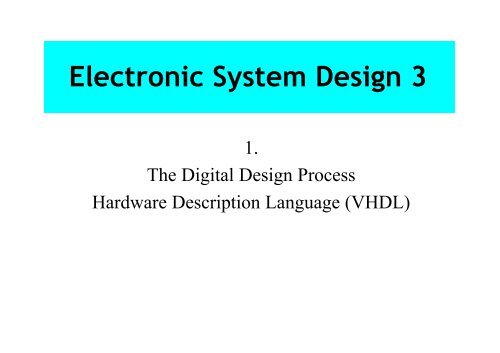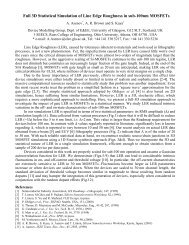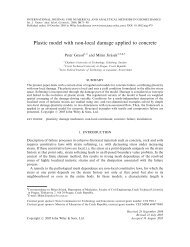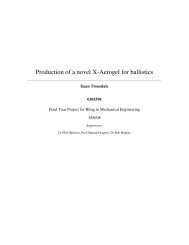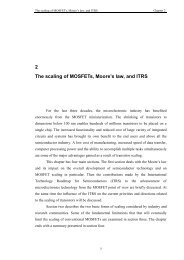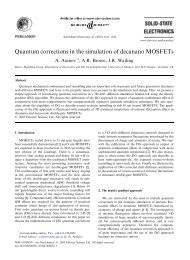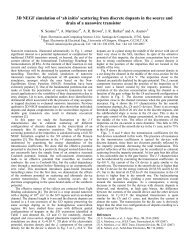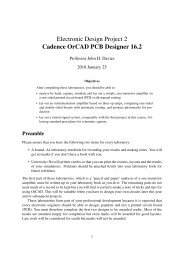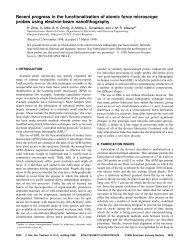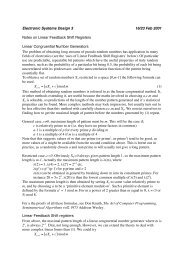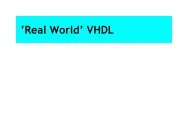01 Notes on Digital Systems
01 Notes on Digital Systems
01 Notes on Digital Systems
Create successful ePaper yourself
Turn your PDF publications into a flip-book with our unique Google optimized e-Paper software.
Electr<strong>on</strong>ic System Design 31.The <strong>Digital</strong> Design ProcessHardware Descripti<strong>on</strong> Language (VHDL)
Bits ‘n’ pieces• Scott RoyRankine Building, Room 307B (between I.Thayne &Device Modelling)S.Roy@elec.gla.ac.uk• Course changes - already covered by Dr. Weaver• Lecture handouts, recommended reading, syllabus, …• Thanks to Craig Slorach! For a fair chunk of this text.2
Nobel Prize in Physics - 2000Jack S. KilbyTexas Instruments, Dallas, Texas, USA“for his part in the inventi<strong>on</strong> of the integrated circuit”(with Zhores Alferov & Herbert Kroemer - heterostructures)3
First Integrated Circuit• Invented at TI in 1958• Comprised of a single transistor and other comp<strong>on</strong>ents <strong>on</strong>a slice of germanium 7/16-by-1/16-inches in size.4
Summary• Design Issues– IC’s and <strong>Systems</strong> are becoming more and more complex andthere is a need for good design analysis and practice.– Managing complexity by breaking down systems intomanageable parts for design and implementati<strong>on</strong>.• Tools for Design & Implementati<strong>on</strong>– Provide a brief refresher <strong>on</strong> Hardware Descripti<strong>on</strong> Languages(HDLs) and c<strong>on</strong>sider how they are really used to build digitalsystems.5
Into C<strong>on</strong>text• Center around procedures used for digital devices– Many principles applicable to all areas of electr<strong>on</strong>ic design.– C<strong>on</strong>centrate initially <strong>on</strong> all digital systems.• Designing chips to perform some specific task– From a simple applicati<strong>on</strong> (e.g. ‘Glue-Logic’)– To a complex device (e.g. DVD, CD, <strong>Digital</strong> TV)– What needs to be optimised ?• Such ‘chips’ are now used everywhere and allow us tobuild electr<strong>on</strong>ic devices that would have been unheard ofeven 5 years ago !6
Some Definiti<strong>on</strong>s• Design– The process of taking a functi<strong>on</strong>al specificati<strong>on</strong> and producing asoluti<strong>on</strong> for this specificati<strong>on</strong>– There may be many different soluti<strong>on</strong>s, but we are <strong>on</strong>ly everinterested in producing a single <strong>on</strong>e ! (although an optimisati<strong>on</strong>criteri<strong>on</strong> may be extensibility).• Implementati<strong>on</strong>– Implementing the design in some form– Or, in simple terms ‘building it’7
Design Issues
Motivati<strong>on</strong>• Building IC’s is just another Engineering Problem !– Principles no different from designing a car, etc.• Electr<strong>on</strong>ic designs are becoming more and more complex– 25 years ago designed with primitive gates (AND, OR, etc.) andc<strong>on</strong>nected these together to form systems.– With the advent of the ASICs (Applicati<strong>on</strong> Specific IntegratedCircuits) and large FPGAs (Field Programmable Gate Arrays)can design a custom IC for each applicati<strong>on</strong> / prototype.– Integrati<strong>on</strong> of general purpose processors and dedicatedhardware needs hardware & software design skills (co-design).– Rebalancing of design criteria.9
Motivati<strong>on</strong>• Commercial factors $$– Cost, speed, power, size, yield, …– Drivers are now more c<strong>on</strong>sumer than military.– C<strong>on</strong>sumer products have a very short lifespan so time to marketis critical.– Design re-use is therefore becoming crucial.• Must have robust methods of design verificati<strong>on</strong>, …10
Motivati<strong>on</strong>Have to get things right first time !• Want to get things right as early as possible as the cost ofchange/ problem fixing increases exp<strong>on</strong>entially with thestage of designCost to FixTime11
Ideal Design Process• So, ideally our design process should…– Work for any size of design from the simplest (1M gates)– Allow new designs to be realized rapidly– Be structured to get the design ‘right first time’ before wecommit to implementati<strong>on</strong>/ manufacture.» Design for test» Design verificati<strong>on</strong>– Re-use parts of existing designs to speed up time to market12
The Problem• It’s the first day of your new job working for a largesemic<strong>on</strong>ductor companyDesign a ‘chip’ to….• So, where do you start ????13
Design Flow -I• Start with some high level functi<strong>on</strong>al specificati<strong>on</strong> ….Joe Bloggs Inc.The system should ……..~~~~~~~~~~~~~~~~~~~~~~~~~~~~~~~~~~~~~~~~~~~~~~~~~~~~~~~~~~~~~~~~~~~~~~~~~~~~~~~~~~~~~~~• e.g. LCD Display Driver, Teletext, Teleph<strong>on</strong>e, etc.• May run to several hundred pages and defines the scopeof our design14
Design Flow- II• So, how do we start implementing ?– Could now sit down and start building the system from logicgates– Would you do this if you were building a car ?… See you in 10 years time !• We require a much more structured and organised designapproach through the use of– Hierarchy– Regularity– Re-use15
Hierarchical Approach- Introducti<strong>on</strong>• Hierarchical Approach to System Design– Split the overall design into discrete blocks which have(typically) a single functi<strong>on</strong> and then c<strong>on</strong>nect these blockstogether to form the complete system (see later)– The process is repeated <strong>on</strong> each of the blocks in the design untila desired level of abstracti<strong>on</strong> is achieved– Eventually, we have a list of blocks (with inputs, outputs andrequired functi<strong>on</strong>ality)– These then have to be implemented (see later)16
Hierarchical Approach- Example• In the example below, the design ‘top’ c<strong>on</strong>tains 2 blocks‘BLOCK1’ and ‘BLOCK2’– BLOCK1 is then sub-divided into another 3 blocksLevel 0TOPLevel 1BLOCK1BLOCK2Level 217
Hierarchical Approach- I• Identify the system inputs, outputs and behaviour– This is in our system specificati<strong>on</strong>• Example- feature teleph<strong>on</strong>e top design1 2 34 5 67 8 9* 0 #KeypadD-AC<strong>on</strong>verterLineC<strong>on</strong>trolDAAInterface(Analog)LCDHandsetSwitchLine C<strong>on</strong>trol &Dialing18
Hierarchical Approach- II• We now split the system into discrete blocks which have(typically) a single functi<strong>on</strong> (termed highly cohesive) andidentify the way in which they are interc<strong>on</strong>nected• An example of this is presented in schematic 1 where thehierarchy of our ‘ph<strong>on</strong>e has been taken down a level togive the internal details of the teleph<strong>on</strong>e IC– The system is now comprised of 5 blocks which perform asingle functi<strong>on</strong> within the whole system (e.g. display c<strong>on</strong>trol)– Could further decompose design– Note that the inputs and outputs are the same as the previouslevel (i.e. keybd[6..0] etc.)19
Feature Teleph<strong>on</strong>e Schematic20
Regularity• Regularity is also useful in the design process– When decomposing a design attempt to form regular structures• Regularity is particularly useful when c<strong>on</strong>sidering thelower-level (layout issues of a design)– E.g. memory design which is made from a ‘tile’ of similar cellsc<strong>on</strong>nected together– If we design a single cell, then all that is required is to replicatethe cells to form the complete memory array• Datapaths also benefit from regularity– e.g. Adder21
Design Reuse- Introducti<strong>on</strong>• Re-Use is very important, especially with fast time tomarket• If we can re-use a block then it can yield a very fastproduced design– As part of the design has already been implemented– Ideally, we drop the block into our top-level design• At the extreme, we have System <strong>on</strong> a Chip (SoC) designswhich are composed of blocks from multiple authorswhich are simply c<strong>on</strong>nected together to form largedevices (e.g. Set Top Boxes for Televisi<strong>on</strong>)22
Design Reuse- Requirements• Block must be well specified and documented– The author may not be the end user so the full functi<strong>on</strong>ality ofthe block should be well documented (both inline within codeand external documentati<strong>on</strong>)• Block generally has to be highly cohesive to be able to bere-used– For example, if we are designing a peripheral block for amicroprocessor (e.g. Dialing block) then it would be better if theblock could be design in two secti<strong>on</strong>s- <strong>on</strong>e general blockc<strong>on</strong>nected to a processor specific block• Other issues (e.g. testability etc.)23
Reuse- The Tradeoff• Functi<strong>on</strong>ality Vs. Silic<strong>on</strong> Real Estate– If we are reusing a design, are we <strong>on</strong>ly using a small set of thefuncti<strong>on</strong>ality ?- if so then this is wasteful (needs more Silic<strong>on</strong>sohigher cost)– E.g. we could use a 64 bit loadable counter every time weneeded a counter but this would be wasteful!– This not <strong>on</strong>ly an issue when selecting a comp<strong>on</strong>ent for a design,we also have to avoid building blocks which offer deluxefuncti<strong>on</strong>ality (e.g. “I’ll make this counter have inverted inputs aswell as normal inputs just in case it’s needed later”)24
Tools for Design &Implementati<strong>on</strong>
Introducti<strong>on</strong>• Using the previous techniques, we now have a design, buthow is it implemented ?• The outcome of the previous steps is essentially a(hierarchical) block diagram with a list of blocks eachwith a specificati<strong>on</strong>– List of inputs and outputs– Specificati<strong>on</strong> of the internal behaviour of the block26
The <strong>Digital</strong> Design Flowentity ANDGATE isport ( A,B: in std_logic;NetlistZ: out std_logic );end ANDGATE;architecture MYARCH of ANDGATE isbeginZ
HDL’s- Motivati<strong>on</strong>• HDL’s = Hardware Descripti<strong>on</strong> Languages• Isn’t our Silic<strong>on</strong> soluti<strong>on</strong> just some highly complexprogram (c.f. a software implementati<strong>on</strong> !) ?• So, wouldn’t it be nice to write our hardware in someprogram type form ?• HDL’s allow us to do this !– We have a text based descripti<strong>on</strong> of the desired functi<strong>on</strong>ality ofthe blocks that we’re trying to design– No l<strong>on</strong>ger symbolic at the design level- so we’re no l<strong>on</strong>gertargeting a specific final architecture28
HDL’s- Background• Broadly 2 different types commercially available• Simple State Machine– e.g. Orcad HDL, Abel, etc.– With these we simply describe state machines– Gets a bit messy when dealing with complex designs– Still useful for some systems (e.g. making up a PLD)• Full Functi<strong>on</strong>ality– e.g. VHDL & Verilog– Works very well for complex designs– We’re going to look at VHDL29


